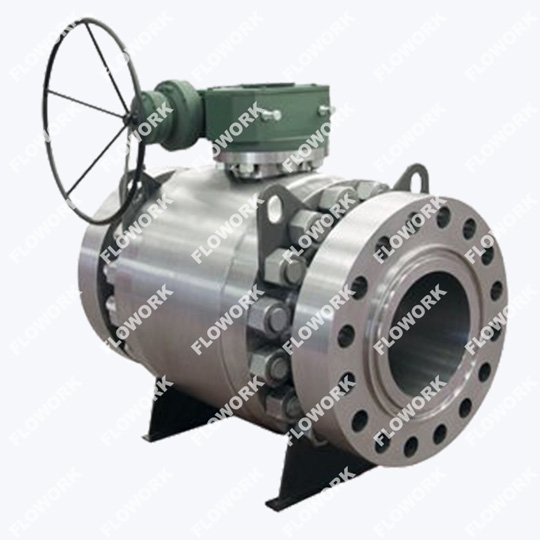
1、You are in restricted area and need password. Please Contact us to obtain documents.
2、PasswordIf you have any questions about quotation or cooperation, please feel free to send us inquiry. Inquiry us
| Size: | 2"-56" |
| Pressure: | 150LB-2500LB |
| Body Material: | CD3MNWCuN, CW2M, Monel, CN7M, 20#Alloys, 4A, 5A, etc. |
| Seal Material: | PEEK, RPTFE, PTFE, DEVLON, HNBR, NYLON, AFLAS, STELLITE,etc. |
| Connection Type: | Flanged, Butt Welded, Socket Welded, NPT |
| Operation: | Hand lever, gear operated, pneumatic, motorized |
| Face to Face Dimension: | ASME B16.10 |
| Flange End Dimension: | ASME B16.5 |
| Butt Welded Dimension: | ASME B16.25 |
| Design and Manufacture: | API 6D |
| Test Standard: | API 598, API 607, API 6FA, ISO 15848-1-2 |
Material can be duplex stainless steel, such as: 4A, 5A, 6A, F51, F52, F53, CD4MCU, etc.
With advantages of both ferritic stainless steel and austenitic stainless steel
Floating ball type and trunnion mounted type are typical ball valve structure.
Excellent corrosion resistance and yield strength due to the material characteristics
2-pieces and 3-pieces; fire-safe and anti-static design
"Widely applied to neutral chloride environment, the oil and gas industry, seawater environment
pulp and paper industry, chemical fertilizer industry, etc."
Sealing surface is not eroded by media when fully opened or closed.
While a ball valve can be used for throttling, it is not the best choice. Ball valves are primarily designed for on/off applications, where the valve is either fully open or fully closed. When used for throttling, the ball valve can cause turbulence in the fluid flow, which can cause erosion and wear on the valve and piping system. Additionally, when a ball valve is partially open, there is a risk of the ball becoming damaged due to high velocity fluid flow, ball valve manufacture.
For throttling applications, globe valves or needle valves are typically a better choice. Globe valves have a linear flow characteristic, which allows for precise flow control at various flow rates. Needle valves have a fine-tipped, threaded plunger that allows for fine adjustments in flow rate, making them ideal for precision flow control.
In summary, while a ball valve can be used for throttling, it is not recommended. Globe valves or needle valves are better suited for throttling applications where precise flow control is required, bronze valve.
A floating ball valve is a type of valve that uses a ball to control the flow of fluid through a pipeline. The ball is held in place by two valve seats and is free to move within the valve body. When the valve is open, fluid flows through the bore of the ball. When the valve is closed, the ball rotates and seals against the valve seats, preventing fluid flow. Floating ball valves are commonly used in various industries and are preferred for their high flow rates, low pressure drops, and easy maintenance, gate valve manufacture.
Soft soldering is not recommended for joining stainless steel ball valves, as it requires a higher temperature than what the valve can withstand, high temperature gate valves. Stainless steel has a higher melting point than soft soldering materials like tin, lead, or silver.
If you need to join stainless steel ball valves, you should consider using TIG (Tungsten Inert Gas) welding or MIG (Metal Inert Gas) welding. These welding techniques use high heat to melt and fuse the stainless steel parts together.
However, if you need to make a temporary repair or seal a small leak in a stainless steel ball valve, you may be able to use an epoxy or a thread sealant designed for stainless steel. Be sure to choose a product that is compatible with stainless steel and follow the manufacturer's instructions carefully, api 6d ball valve.
White corrosion on ball valves is typically caused by exposure to moisture or corrosive substances, and can lead to pitting and other forms of damage. To prevent it, it is important to choose the correct materials for the valve and its environment, properly maintain the valve, and avoid exposure to corrosive substances, forged ball valve.
NACE stands for the National Association of Corrosion Engineers. In the context of stainless steel ball valves, NACE refers to a set of standards developed by the organization to address corrosion resistance in equipment used in harsh environments, such as the oil and gas industry. NACE-compliant stainless steel ball valves are designed to resist corrosion and damage from exposure to chemicals, high temperatures, and high pressures. These valves are often used in offshore drilling, pipeline transportation, and other applications where extreme conditions are present, carbon steel gate valves.
Send us a message if you have any questions or request a quote.

A reply from our experts within 24 hours

The latest detailed product catalugue

One-stop service for your project